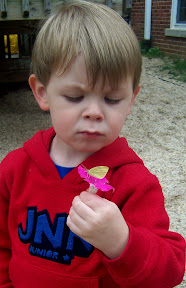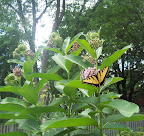Update on the success of using local butterflies
By Peggy Ashbrook
Posted on 2010-06-16
 Yes, I will do this again next spring! We had caterpillars crawling out of the net housing, more caterpillars appearing than expected, wasps pupating next to their caterpillar host, a few deaths due to neglect, and beautiful (is there any other kind?) butterflies emerging from their chrysalids. My plan to introduce the butterfly life cycle to the preschool classes I work with using only locally-found butterfly eggs and caterpillars worked fairly well (see post of May 7, 2010). While not as certain as ordering caterpillars from a biological supply company, I was able to get caterpillars into every classroom. There were fewer caterpillars for each classroom but most children got to see the life cycle beginning with the eggs before the caterpillars hatched. I only use the Cabbage White and Black Swallowtail butterflies because they are not endangered, and locally abundant.
Yes, I will do this again next spring! We had caterpillars crawling out of the net housing, more caterpillars appearing than expected, wasps pupating next to their caterpillar host, a few deaths due to neglect, and beautiful (is there any other kind?) butterflies emerging from their chrysalids. My plan to introduce the butterfly life cycle to the preschool classes I work with using only locally-found butterfly eggs and caterpillars worked fairly well (see post of May 7, 2010). While not as certain as ordering caterpillars from a biological supply company, I was able to get caterpillars into every classroom. There were fewer caterpillars for each classroom but most children got to see the life cycle beginning with the eggs before the caterpillars hatched. I only use the Cabbage White and Black Swallowtail butterflies because they are not endangered, and locally abundant.
Lessons learned:
- Just because there were an abundance of Eastern Tent moth caterpillars in the fruit trees last year, does not mean there will be any this year. The weather has been unusually cool and I haven’t spotted any of the hairy caterpillars or their webs in tree branches.
- The paper plate and net housing doesn’t fool Black Swallowtail caterpillars who are searching for either fresher food or a high place to pupate. Next time I will add fresh food cuttings several times a week to keep them happy. I may make the fabric overlap wider, or tape the overlap closed. We should try our best to provide for all their needs.
- There are tiny wasps that parasitize Cabbage White butterfly caterpillars, laying their eggs in the caterpillar body where they hatch and feed, emerging later to form pupa cocoons. Ick, but that is a beautiful system for the wasps. See more about this and moths of the cabbage plant family on the Ontario, Canada Ministry of Agriculture Food and Rural Affairs page on Caterpillar Pests of Cruciferous Crops. Trying to understand where this new set of pupae came from may be too much for young children unless they have observed a caterpillar growing and changing into a butterfly several times. So I said that these new pupae are insects that I don’t know enough about to raise and care for them indoors so we put that leaf out in the garden.
- Unseasonably cool weather may mean newly emerged butterflies need to be kept and fed indoors for a day or two. The cool temperature seemed to make the one pictured below sluggish, allowing a very close and careful look.
- I’m going to plant patches of fennel in more locations so I will have more places to gather Black Swallowtail butterfly eggs and larvae.
 Most of the 15 classrooms had butterflies to release at the end of six to ten weeks. Teachers sent me text messages, took pictures and gushed about the excitement the children expressed at seeing the butterfly fly away. “It went up and up and up!” was one child’s description.
Most of the 15 classrooms had butterflies to release at the end of six to ten weeks. Teachers sent me text messages, took pictures and gushed about the excitement the children expressed at seeing the butterfly fly away. “It went up and up and up!” was one child’s description.
 I still don’t have any Monarch butterfly larvae on the milkweed plants and think at this late date that the migrating adults have passed my yard by and gone north. Perhaps the next generation of Monarch butterflies will decide to lay eggs here. The flowers of the milkweed have been very popular with many species of bees, wasps, and this Tiger Swallowtail butterfly.
I still don’t have any Monarch butterfly larvae on the milkweed plants and think at this late date that the migrating adults have passed my yard by and gone north. Perhaps the next generation of Monarch butterflies will decide to lay eggs here. The flowers of the milkweed have been very popular with many species of bees, wasps, and this Tiger Swallowtail butterfly.
What kinds of lifecycles do you talk about and observe in your classroom?
I have much to learn about raising butterflies from eggs. What suggestions do you have?
Peggy
Disclaimer: The views expressed in this blog post are those of the author(s) and do not necessarily reflect the official position of the National Science Teaching Association (NSTA).


